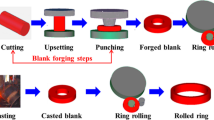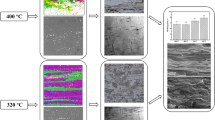Abstract
Microstructure determines the comprehensive mechanical properties and service life of ring parts. In this study, ring rolling process is considered as a multi-pass process which is parted into four phases, and the microstructure evolution model is then established based on the characteristics of this multi-pass process by combining with a 3D coupled thermo-mechanical FE model. By contrasting with experiment results, the microstructure evolution model is actually proven can be competently applied to predict the microstructure of the formed ring. Also through comprehensive analysis on distribution of recrystallization fractions based on the microstructure evolution model, conclusions can be summarized as following. (1) It is inaccurate to predict the microstructure by regarding the ring rolling as a single-pass deformation. The ring rolling process should be parted into different phases, and for each phase, the singlepass microstructure evolution model is adapted. (2) Different with single-pass deformation, due to the high temperature dwelling phase during ring rolling process, meta-dynamic recrystallization (MDR) is another important grain refinement mechanism besides dynamic recrystallization (DR). (3) MDR has different distribution trends with DR, which is benefit not only for grains refinement but also for microstructure uniformity. (4) Rolling penetration is obviously improved with feed rate increases, whereas, unduly high feed rate leads to recrystallization fraction decrease in outer layer area, which is adverse to microstructure uniformity.
Similar content being viewed by others
Abbreviations
- X r :
-
recrystallization volume fraction
- X nr :
-
non-recrystallization volume fraction
- X dr :
-
dynamic recrystallization volume fraction
- X mdr :
-
meta-dynamic recrystallization volume fraction
- D dr :
-
grain size for dynamic recrystallization
- D mdr :
-
grain size for meta-dynamic recrystallization
- D r :
-
average grain size for recrystallization
- D nr :
-
grain size for non-recrystallization
- D age :
-
average grain size
- Z:
-
Zener-Hollomon parameter
- Q:
-
activation energy of deformation
- T:
-
thermodynamic temperature of element
- \(\overset{\lower0.5em\hbox{$\smash{\scriptscriptstyle\leftharpoonup}$}} {\varepsilon } \) :
-
effective strain
- \({\overset{\lower0.5em\hbox{$\smash{\scriptscriptstyle\leftharpoonup}$}} {\varepsilon } _c}\) :
-
critical effective strain
- \({\overset{\lower0.5em\hbox{$\smash{\scriptscriptstyle\leftharpoonup}$}} {\varepsilon } _p}\) :
-
peak strain
- \({\overset{\lower0.5em\hbox{$\smash{\scriptscriptstyle\leftharpoonup}$}} {\varepsilon } _{0.5}}\) :
-
ete]ffective strain leading to X dr
- t 0.5|dte]welling time leading X mdr|0.5:
-
dwelling time leading Xmdr 0.5
- \(\dot \bar \varepsilon \) :
-
strain rate
- \(\Delta \overset{\lower0.5em\hbox{$\smash{\scriptscriptstyle\leftharpoonup}$}} {\varepsilon } \) :
-
strain increment
- \({\overset{\lower0.5em\hbox{$\smash{\scriptscriptstyle\leftharpoonup}$}} {\varepsilon } _m}\) :
-
accumulated strain
References
Brand, A., Karhausen, K., and Kopp, R., “Microstructural Simulation of Nickel Base Alloy Inconel 718 in Production of Turbine Discs,” Materials Science and Technology, Vol. 12, No. 11, pp. 963–969, 1996.
Ceretti, E., Giardini, C., and Giorleo, L., “3D Simulation of a Hot Ring Rolling Industrial Process,” International Journal of Material Forming, Vol. 3, No. 1, pp. 323–326, 2010.
Giorleo, L., Giardini, C., and Ceretti, E., “Validation of Hot Ring Rolling Industrial Process 3D Simulation,” International Journal of Material Forming, Vol. 6, No. 1, pp. 145–152, 2013.
Yea, Y., Ko, Y., Kim, N., and Lee, J., “Prediction of Spread, Pressure Distribution and Roll Force in Ring Rolling Process using Rigid–Plastic Finite Element Method,” Journal of Materials Processing Technology, Vol. 140, No. 1–3, pp. 478–486, 2003.
Allwood, J. M., Tekkaya, A. E., and Stanistreet, T. F., “The Development of Ring Rolling Technology,” Steel Research International, Vol. 76, No. 2–3, pp. 111–120, 2005.
Allwood, J. M., Tekkaya, A. E., and Stanistreet, T. F., “The Development of Ring Rolling Technology: Part 2 Investigation of Process Behaviour and Production Equipment,” Steel Research International, Vol. 76, No. 7, pp. 491–507, 2005.
Yang, H., Wang, M., Guo, L. G., and Sun, Z. C., “3D Coupled Thermo-Mechanical Fe Modeling of Blank Size Effects on the Uniformity of Strain and Temperature Distributions during Hot Rolling of Titanium Alloy Large Rings,” Computational Materials Science, Vol. 44, No. 2, pp. 611–621, 2008.
Zhu, S., Yang, H., Guo, L., Hu, L., and Chen, X., “Research on the Effects of Coordinate Deformation on Radial-Axial Ring Rolling Process by Fe Simulation based on in-Process Control,” The International Journal of Advanced Manufacturing Technology, Vol. 72, No. 1–4, pp. 57–68, 2014.
Kim, N., Kim, H., and Jin, K., “Optimal Design to Reduce the Maximum Load in Ring Rolling Process,” Int. J. Precis. Eng. Manuf., Vol. 13, No. 10, pp. 1821–1828, 2012.
Ma, Y., Wang, Z., Liu, D., Zhu, X., and Yang, Z., “Optimization of Rotational Speed of Main Roll in Profile Ring Rolling of GH 4169 Alloy,” Acta Aeronautica et Astronautica Sinica, Vol. 32, No. 8, pp. 1555–1562, 2011.
Zhu, X., Liu, D., Yang, Y., Hu, Y., Liu, G., and Wang, Y., “Effects of Blank Dimension on Forming Characteristics during Conical-Section Ring Rolling of Inco718 Alloy,” The International Journal of Advanced Manufacturing Technology, DOI No. 10.1007/s00170–015-7839-y, 2015.
Glowacki, M. and Kuziak, R., “Application of Coupled Thermal-Mechanical Model to the Numerical Analysis of the Microstructure Development during Rolling and Air Cooling of Rails,” Proc. of Complast 5 (Computational Plasticity), pp. 1313–1316, 1997.
Jang, Y.-S., Ko, D.-C., and Kim, B.-M., “Application of the Finite Element Method to Predict Microstructure Evolution in the Hot Forging of Steel,” Journal of Materials Processing Technology, Vol. 101, No. 1, pp. 85–94, 2000.
Bontcheva, N. and Petzov, G., “Microstructure Evolution during Metal Forming Processes,” Computational Materials Science, Vol. 28, No. 3, pp. 563–573, 2003.
Bontcheva, N., Petrov, P., Petzov, G., and Parashkevova, L., “Finite Element Simulation of Strain Induced Austenite–Martensite Transformation and Fine Grain Production in Stainless Steel,” Computational Materials Science, Vol. 40, No. 1, pp. 90–100, 2007.
Ding, H., Hirai, K., Homma, T., and Kamado, S., “Numerical Simulation for Microstructure Evolution in AM50 Mg Alloy during Hot Rolling,” Computational Materials Science, Vol. 47, No. 4, pp. 919–925, 2010.
Hu, Z. M., Brooks, J. W., and Dean, T. A., “Experimental and Theoretical Analysis of Deformation and Microstructural Evolution in the Hot-Die Forging of Titanium Alloy Aerofoil Sections,” Journal of Materials Processing Technology, Vol. 88, No. 1, pp. 251–265, 1999.
Sun, Z. C., Yang, H., and Ou, X. Z., “Effects of Process Parameters on Microstructural Evolution during Hot Ring Rolling of AISI 5140 Steel,” Computational Materials Science, Vol. 49, No. 1, pp. 134–142, 2010.
Wang, M., Yang, H., Zhang, C., and Guo, L.-g., “Microstructure Evolution Modeling of Titanium Alloy Large Ring in Hot Ring Rolling,” The International Journal of Advanced Manufacturing Technology, Vol. 66, No. 9–12, pp. 1427–1437, 2013.
Liu, D. and Luo, Z.-j., “Mathematical Model for Microstructure Evolution of GH4169 Alloy during Hot Working Process,” Chinese Journal of Nonferrous Metals, Vol. 13, No. 5, pp. 1218–1221, 2003.
Author information
Authors and Affiliations
Corresponding author
Rights and permissions
About this article
Cite this article
Zhu, Xl., Liu, D., Xing, Lj. et al. Microstructure evolution of inconel 718 alloy during ring rolling process. Int. J. Precis. Eng. Manuf. 17, 775–783 (2016). https://doi.org/10.1007/s12541-016-0095-8
Received:
Revised:
Accepted:
Published:
Issue Date:
DOI: https://doi.org/10.1007/s12541-016-0095-8




